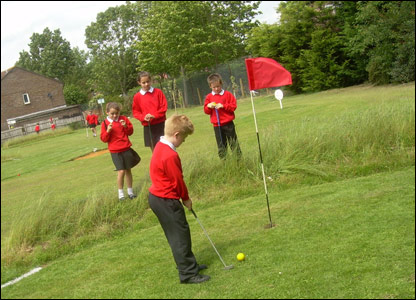This interview first appeared in “China Real Estate Business,” a Chinese-language newspaper with a national circulation in China, on November 12, 2011.
1. When did your company start to focus on the Chinese golf industry? Did you focus especially on golf course management and operations? What kind of problems have you discovered?
JOHN STRAWN: Hills & Forrest is a golf course architectural firm, so our focus is on designing courses. We have also formed a joint venture with two Chinese partners, one of which, Cheng Jun Golf, does own and operate courses. The courses they operate are private membership courses, and have been popular because they have good teaching academies as well as good restaurants in the clubhouse. The Tianan Club in Beijing, not far from the main airport, is a Cheng Jun course.
We focused on China because we believe the Chinese golf industry will grow substantially in the years ahead. But to do so successfully, the China golf industry needs to focus on how it can stimulate demand and attract more players. Right now, all of China’s golf courses are private membership clubs, with the exception of a few resort courses open for green fee play. But the concept that is most popular in the USA, the so-called daily fee course, has not made any inroads into China yet. Most towns and cities in the US own and operate golf courses for their citizens, not expecting them to make a profit but simply to cover operating expenses. Sometimes they are even subsidized, just as a recreation center or swimming pool would be, but that is rarer these days. Still, most golf courses in the US manage an operating profit, but the real value of golf courses over the last four decades to developers has been their contribution to real estate values. Houses on golf courses sell for higher prices than houses without access to golf. This is partly just because golf provides a beautiful landscape—a kind of garden, with grass and trees and clean air. The recreational aspect is a bonus. Golf is also good for a player’s health. Walking especially is good exercise. I see many Chinese courses using golf carts, and I don’t think this is a good tendency. The best courses are walkable, and walking should be encouraged, especially given the availability of caddies in China.
2. According to research institutions, 80% of the golf courses in China don’t make money. Does this research match what you know about China? What is the reason for this situation?
JOHN STRAWN: To understand this situation, you have to think through what a golf course has to sell. A golf course owns tee times. Every day, it has so many available times for people to play golf. Let’s assume that we want to put groups out at ten minute intervals. That is six groups of four players every hour, or 24 players per hour. (This is an optimal spacing—eight minute starts are more common in the US.) If an average round takes four and one half hours, and the first round goes off at 7 a.m. and the last at 4 p.m., that means the course has 216 tee times to sell that day. (9 hours of starting times X 24 players per hour.) The maximum revenue yield would be based on “selling” all of those tee times. That is what well-managed daily fee golf courses do in the US. They can discount last minute rounds, for example, or offer specials via the internet. In China, because the courses are not based on daily fees, the operations have to be supported by collecting monthly dues from members. Fundamental Rule: It costs the same to maintain a course at a proper standard whether anyone plays it or not. If you are not filling up the tee times, the cost per round to maintain the course goes way up. At some point, this is not sustainable.
3. What are the attributes for a successful golf course? What kind of business pattern would make a course to be successful?
JOHN STRAWN: We must first define what our expectations are. For a members’ course, the measure of success is different from a course based on daily fee play which must make a profit. Members’ or private courses may measure their success on the prestige of their membership, or on tournament play. But a daily fee course is strictly a profit-making entity whose success is measured just as any other business measures success—return on investment. If developers de-couple the golf course from the real estate returns, then the golf course functions more like infrastructure. It is like having roads and power and water service—it is necessary for the overall success of the project—that is, for selling real estate at good prices—but doesn’t bring in a direct return. We don’t expect roads and power lines to “make money,” and if we divorce the real estate from the golf operations, and don’t put the golf course on a business basis, it makes no sense to expect the golf course to somehow succeed as a business.
4. Golf courses in China depend too much on combining with real estate. Is this healthy? What’s the difference between China and other countries in regard to golf and real estate?
JOHN STRAWN: As we have noted already, golf courses need to attract more play to succeed as stand-alone businesses. If the only model is the private membership club, this won’t happen. Some clubs in Europe and the US are what are called “semi-private”—that is, the course has members but also allows outside play. This is done in some cases in China, also, but the highest status golf courses are still private members’ courses. This does not have to be the case. In the US, there are many famous private clubs, but there are also resorts which are prestigious to play and earn substantial profits. Examples of this would be Pebble Beach, Pinehurst, and perhaps the most important and creative golf development of the last twenty years, Bandon Dunes Resort in Oregon. It has no real estate to sell, only lodging in hotel rooms and villas, and its four courses earn millions each year for its developer.
5. To get out of this dilemma, what should Chinese golf courses do for a positive future?
JOHN STRAWN: I believe the Chinese golf industry needs to focus on developing a platform for popular golf—that is, inexpensive, accessible public courses. These can be 9 holes, for example, with a driving range. Many, many smaller US cities feature 9 hole courses. Developers and members’ courses should contribute to the development of daily fee, muni-type courses to develop the next generation of golfers. Cities and towns should look to developing golf courses as public amenities, like parks. This will also create jobs, and inspire a new generation of Chinese golfers, who can take their place on the world golf stage.
China is already arguably the most important contributor to the world golf economy. Why? Because most of the clubs, balls, bags, shirts, hats and shoes are made in China and sold to golfers all over the world. I don’t know what the dollar volume of the China golf manufacturing is, but surely it is in the billions. If China wants to encourage domestic consumption of articles made in China, the golf industry is a good place to focus. There is a potential demand for golf in China that would make it the number one golf country in the world within thirty years.
6. Do you know the details about profits, quantity and the potential developing space of golf courses in China?
JOHN STRAWN: China has some of the most beautiful landscapes in the world, but clearly not all of it is available or appropriate for golf. Worldwide, we know from surveys that golfers prefer to play on seaside courses. Pebble Beach, Bandon Dunes, St Andrews and the great Scottish links, such as Aberdeen and Turnberry, and the great Irish courses, such as Ballybunion or Lahinch, are along the sea. China has an immense coastline, where golf could be developed. Lake-side courses are also popular. Core courses must be a key component of China’s long-term golf strategy, along with a focus on public golf. China must find ways to stimulate demand. In so-called “developed golf countries,” such as the UK, the USA, and Sweden, about 7% of the people play golf. That’s roughly 27 million people in the USA, which has about 18,000 golf courses (on only a slightly larger land mass than China.) China has 1.3 billion people. If 7% of Chinese people played golf, that would be 91,000,000 golfers—more than twice the total number of golfers in the world today! Even if only 1% of Chinese people played golf, that would be 13,000,000 golfers. The rule of thumb is that you need roughly one golf course per 1,500 golfers. If China reaches a golf participation rate even of 1%, according to this formula it would “need” more than 8,000 golf courses. So the potential for growth in China is enormous. What China must do to encourage golf development is to support public golf, and develop and operate golf courses using only the very best sustainable designs and management practices, to assure that the water supply is clean and preserved, and that the environment will benefit from a healthy landscape. The knowledge of how to do this exists–it just needs to be applied with conviction.



